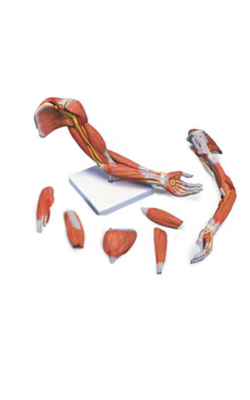Main Model

60 Superficial branch of ulnar nerve

The Ulnar Nerve in Hand
The ulnar nerve leaves the forearm by emerging from deep to the tendon of the flexor carpi ulnaris. It continues distally to the wrist via the ulnar (Guyon) canal. Here the ulnar nerve is bound by fascia to the anterior surface of the flexor retinaculum as it passes between the pisiform (medially) and the ulnar artery (laterally).
Just proximal to the wrist, the ulnar nerve gives off a palmar cutaneous branch, which passes superficial to the flexor retinaculum and palmar aponeurosis and supplies skin on the medial side of the palm.
The dorsal cutaneous branch of the ulnar nerve supplies the medial half of the dorsum of the hand, the 5th finger, and the medial half of the 4th finger. The ulnar nerve ends at the distal border of the flexor retinaculum by dividing into superficial and deep branches.
The superficial branch of the ulnar nerve supplies cutaneous branches to the anterior surfaces of the medial one and a half digits. The deep branch of the ulnar nerve supplies the hypothenar muscles, the medial two lumbricals, the adductor pollicis, the deep head of the flexor pollicis brevis, and all the interossei. The deep branch also supplies several joints (wrist, intercarpal, carpometacarpal, and intermetacarpal). The ulnar nerve is often referred to as the nerve of fine movements because it innervates most of the intrinsic muscles that are concerned with intricate hand movements.
Superficial Branch of Ulnar Nerve
Origin: Arise from ulnar nerve at wrist as they pass between pisiform and hamate bones
Course: Passes palmaris brevis and divides into two common palmar digital nerves
Distribution: Palmaris brevis and sensation to skin of the palmar and distal dorsal aspects of digit 5 and of the medial (ulnar) side of digit 4 and proximal portion of palm